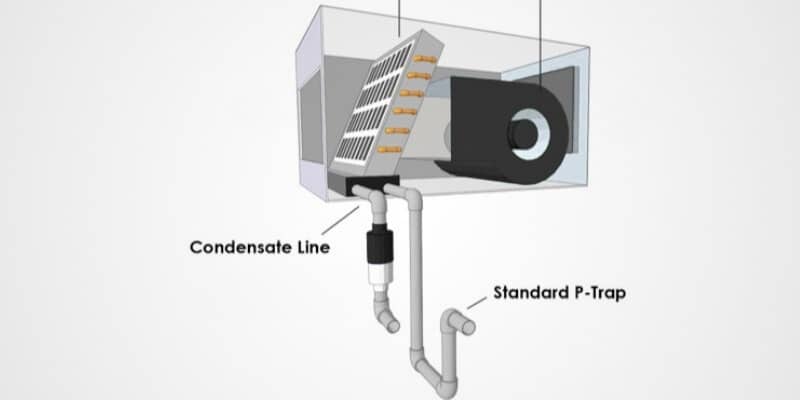An AC condensate drain line is the most common HVAC repair or service that needs to be done. What is an AC drain line? How to install a condensate drain line? Where does it run? In this post, we’ll answer some of the most frequently asked questions about the AC condensate drain line.
An AC condensate drain line should run from your unit inside to the area outside. The drain line ends at the pipe that leads to the outside of your house. On the other hand, the condensate drain access point is the capped pipe next to or near your indoor AC unit.
Keeping up with the condition of your condensate drain lines can help your air conditioning system in a big way. So keep reading to find out more about installing a drain line and any problems that might come up.
What Is a Condensate Drain Line?
A condensate drain line is a pipe that runs through the central air conditioning system of a house or building and leads outside. Most condensate lines are made of PVC pipe or metal, and they act as a funnel for the moisture and condensation that form on the evaporator coils of air conditioners as they run.
A standard air conditioner unit lets you see where the drain line ends from the outside. As the system runs, water drips out, and moisture builds up. One of the most important parts of an air conditioner is the condensate drain line. It keeps too much moisture from building up, which could damage the ductwork and insulation.
During the hot months, you need to clean your condensate drain line often to keep it from getting clogged. Clogged AC drain lines can lead to mold and mildew growth and a rise in humidity, which can make the air inside the house smell bad.
Air Conditioner Drain Line Inside House
The drain line of your air conditioner primarily runs from the indoor AC unit outside to near the outdoor unit. It’s the pathway that the condensation created during the cooling process takes to exit from the indoor unit to the outdoors. Knowing where it terminates near the outdoor unit can be handy, especially when checking for any clogging or blockages that might occur over time.

The air conditioner drain line inside a house is typically a pipe made of PVC, either white or copper in color. It’s a simple, unassuming component in various locations within your home, such as inside a utility closet, garage, or attic. These are places where it can quietly do its job without drawing much attention. Identifying the drain line and knowing its physical attributes can be quite helpful, especially when performing maintenance tasks like clearing a clog.
Being familiar with the drain line’s location and what it looks like can save you time and possibly prevent any issues related to clogging or blockages. It’s a small yet crucial step towards better understanding your air conditioning system and ensuring it operates efficiently to keep your home comfortable.
Locating Your AC Condensate Drain Line
Most drain lines for condensation are put in from the inside of the house to the outside. In new homes, the lines are put in as part of the plumbing system. In older homes, the lines are put separately in the attic.
AC condensate drain lines can also be installed based on what you want and what your property needs. No matter where or how you locate it, though, it’s important that your drain line sends condensation outside your home in the right way.
Where Does the AC Condensate Drain Line Go?
So, where does the water that drains out of the AC drain line go? It takes the water from your indoor unit and puts it on your grass outside. Often, your drain line goes from your indoor units to the outside, near where your outdoor units are.
If you go outside and look near your HVAC system, you might see a pipe that leads to your house. Here is the end of your drain line.
How To Install A Condensate Drain Line The Right Way
Condensate drain lines get rid of the water that forms when the evaporator in the air conditioner works. The most important part of this project is getting the drain line’s path right because that will tell you how much pipe material you need.
Here are 5 steps for installing an AC condensate drain line:
1. Examine your AC unit.
Air conditioning units come in different shapes, sizes, and designs. You should look at the outside parts of the unit, preferably with the help of a manual or guide, to find where the condensate drains. Care should be taken with the exam.
If AC units were previously installed or hooked up to a power source, make sure the AC unit is disconnected from the power source before you look at it.
2. Mark where the drainage line will go.
Most of the time, decisions about where to run ac condensate drain line are made when the building is designed. The structural drawing might include more information about how the pipe will be routed so that it fits its environment best and causes fewer problems.
But if that’s not the case, it’s best to look at the house where the AC is to find the best way to get the drainage through.
3. Choose the right materials and tools.
Choosing the right tool for the job is very important. This comes from having an idea of what you’re about to do and getting ready for it.
Before starting the job, you should carefully choose the tools you’ll need and have them ready to go. If you don’t know what materials you might need, a list of them is below.
However, the pipes you use will depend on your personal preference or where you’re putting the pipes.
PVC, PEX, and CPVC pipes are all good choices for air conditioning drain lines. However, they need to be protected from UV rays, which will cause the price to go up a little bit. Copper and stainless steel are also good options.
4. If necessary, cut a path for the pipe or make a channel for it.
After you know where to run ac condensate drain line, you may be asked if you want them to go through a wall or run on the surface.
Both have their pros and cons, but if it’s just an AC condensate drain, we’d rather our clients put it on the wall or outside where it’s easy to get to for maintenance and repairs. You can do this by drilling clips into the wall and running pipes through them.
If you want them in the walls, though, you’ll need a chisel, a mallet, or a hammer drill, depending on whether the walls are made of concrete or wood. For the length of time, you want your pipes to run, you’d have to cut a hole in the wall and open it all the way to its end.
At some point, the pipe will have to go out into the outside world. This will be a hole or some kind of opening. This hole should be found, and a drill should be used to make it. To make a bigger hole, you can mark the size of the hole on the wall, drill 6 to 8 holes around the edge, and then use a chisel and hammer to punch the hole.
5. Hook up the pipes and run the drain line.
The following steps should be taken to connect and run a pipe for condensate discharge.
Measure the size of the condensate outlet. The size of the condensate outlet should be found and measured, preferably with tape. The outlets are usually 1/2 inches in size, but this can change in some cases.
Use a socket to connect the outlet to the pipe. A threaded male socket can be used if the condensate outlet is threaded internally, or a threaded female socket can be used if the condensate outlet is threaded externally. If the outlet isn’t threaded at all, a plane pipe coupling of the same size can be glued or primed to the outlet and then connected to a short length of drainage pipe.
Make a trap big enough to stop air from sucking in but small enough to let water flow through. After the first or second turn of the drainage line (using pipe bends), a trap should be made with the dimensions shown in the diagram below.
A vent that is too shallow would let moisture escape or dry out quickly, and a trap that is too deep would likely send moisture from the draining pipes back to the AC unit, which is a bad sign. So there needs to be a balance in-depth and a pipe to let the air out.
Run the final discharge line down to the place where it will be dumped. If the pipes are vertical, gravity will take care of how the condensate moves. But if the drainage runs horizontally, it should be sloped so that the depth changes by 1 cm for every 1 meter to its endpoint.
Final Words
The above steps on installing an ac condensate drain line are just a guideline. Always consult local codes in your area when installing an AC condensate drain line.
The best way to decide where to run AC condensate drain line from your home depends mostly on how it is built and what you want. While it is a simple piece of equipment, it needs a lot of planning and accuracy. It’s important to make sure it works well by installing and maintaining the AC condensate drain line correctly.






